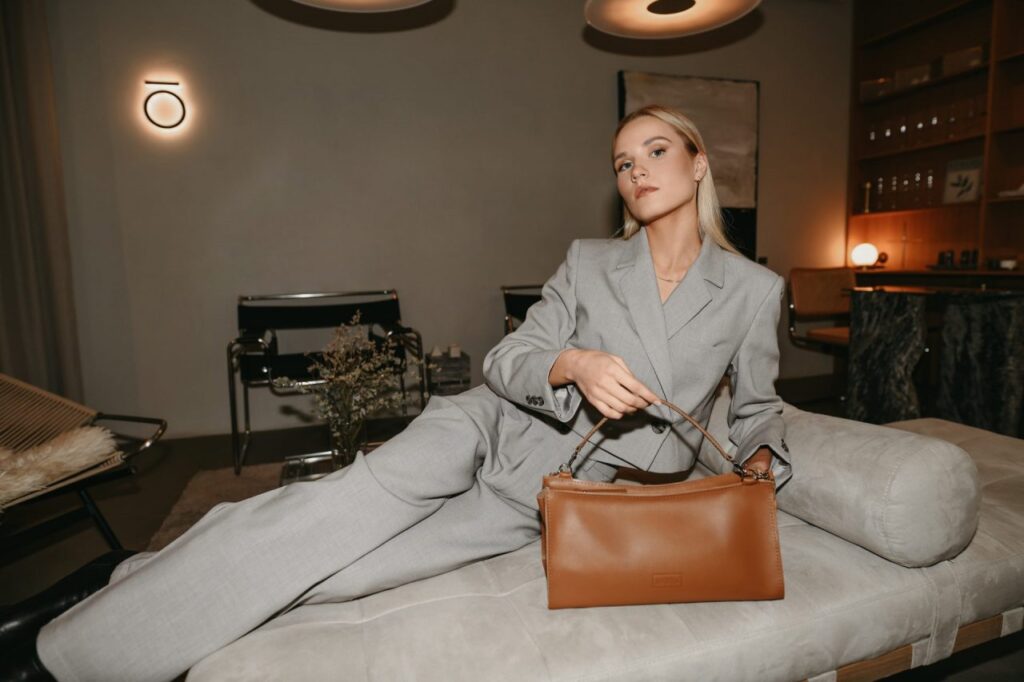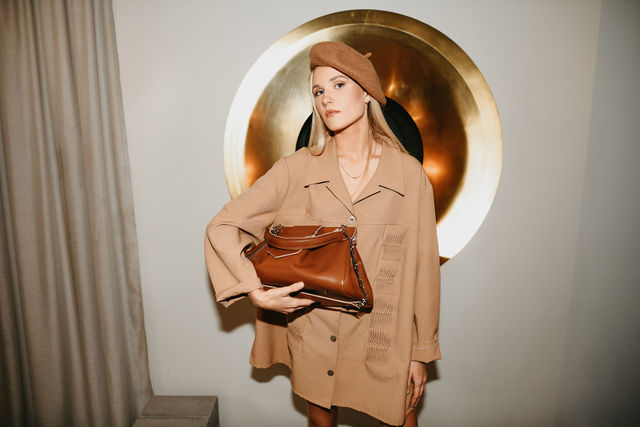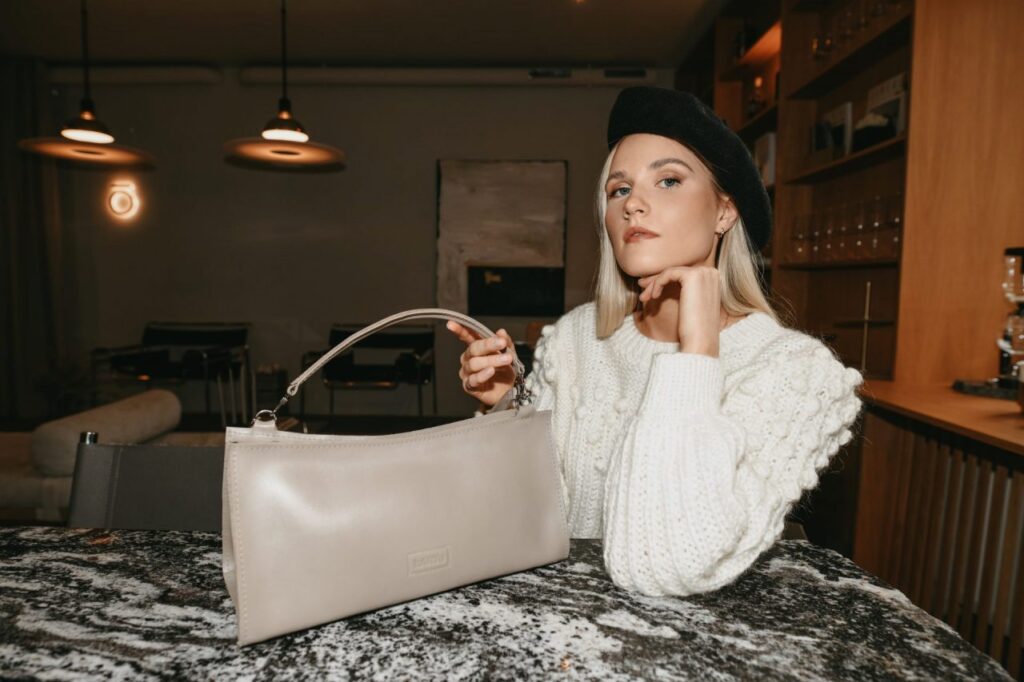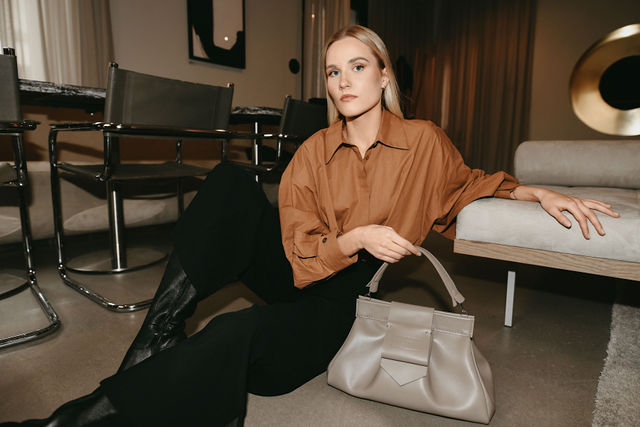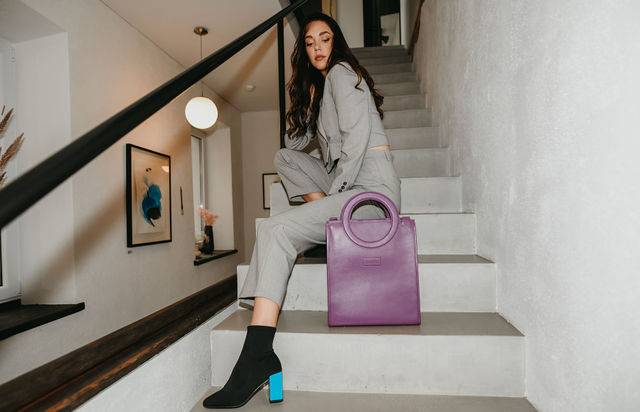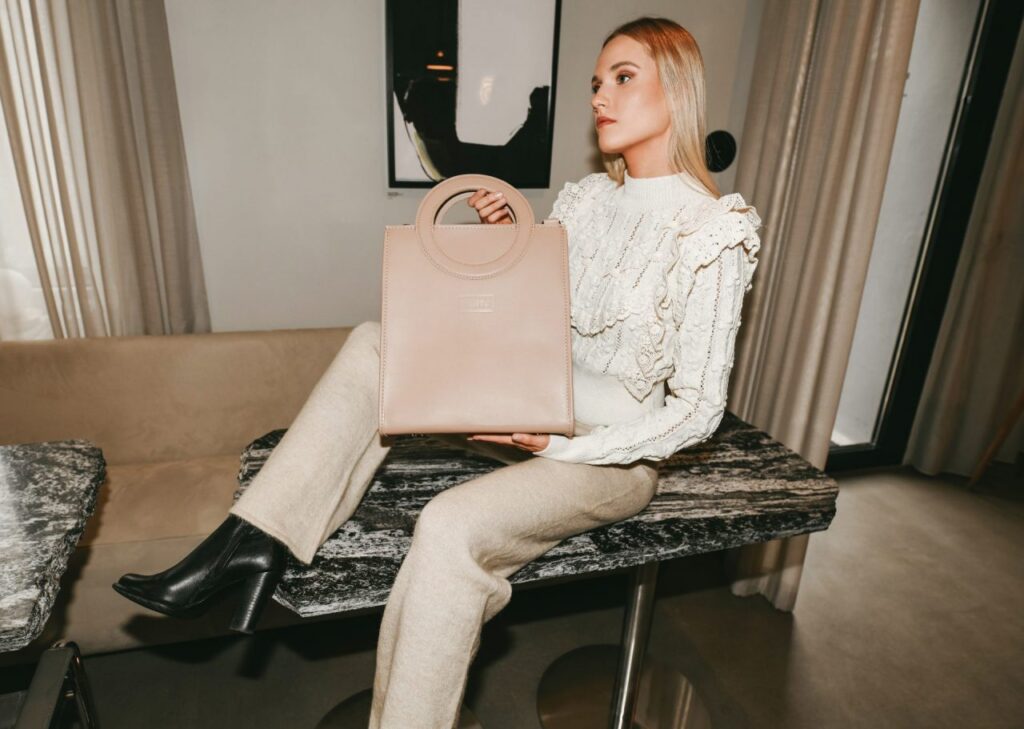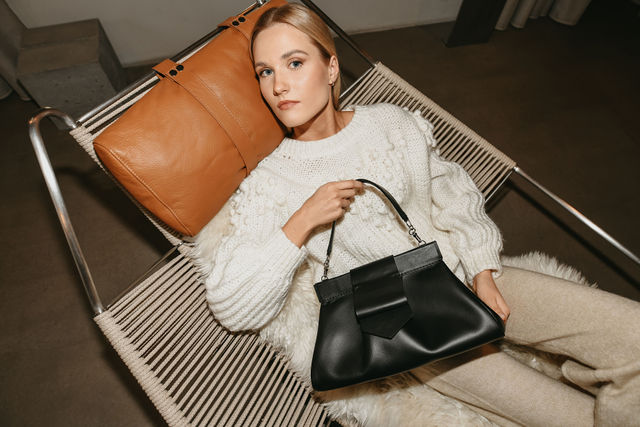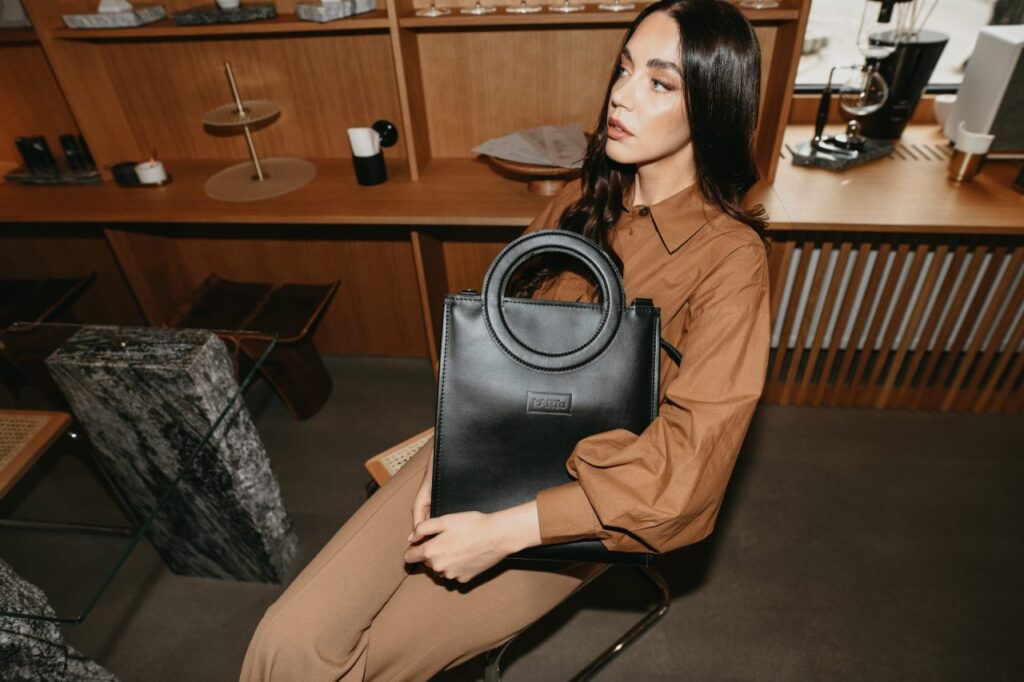AUTUMN WINTER 21/22
“Ingrida Jasinskė has been in the business of handmade handbags for almost a decade. Handbag studio “kARTu” is loved and appreciated not only by the people of Kaunas, but also by fashion accessories lovers from all over Lithuania. This time, we talked to the brand’s creative director not about photoshoots or sophisticated products, but about everything behind the scenes: the production of handbags, creative processes and the daily challenges of developing a fashion business towards sustainability.
Ingrida, you asked to describe yourself as the creative director of the “kARTu” studio. Why do you avoid calling yourself a designer? Do you disagree with the created image that the work of a designer is one of the most fashionable and sought-after professions in Lithuania?
In the press, I keep seeing headlines with the catchy word “designer”. I truly believe that to be called by that name you have to deserve it. If you want to be called a doctor, you have to study medicine for years. It’s the same with designers: once you create a clothing collection or a single object, you do not become one. You have to invest your time and energy in detailed design studies and constantly improve your skills. Calling yourself a designer when you don’t have a degree in that field, in my opinion, is unprofessional to say the least.
Who then hides behind the duties of “creative director”?
For me, this role includes marketing, fashion, business, creativity and knowledge of leathercraft. Nowadays, it is no longer enough to just have a beautiful product, to build a brand for a discerning and socially conscious audience. There are already far too many products in the world. A modern product must take on a greater responsibility towards society, have a clear mission and its aesthetics must directly reflect the values and lifestyle of the customer. The creator must take responsibility for the product, from its entry into the consumption chain to the end of its wear cycle. It is also important to establish a close relationship with the buyer, where mutual trust can be felt. My daily task is to oversee everything from a high-level perspective and cover a wide range of different areas.
So maybe it would really be easier to just be a free creator, an artist?
Here comes a false impression again! In the public space I see a very exalted, almost idolized image of the fashion designer. And the reality is so earthly! If you imagine that fashion industry professionals only hang out at bohemian parties and enjoy their creations on the covers of magazines, I must disappoint you. It’s a constant, patient, sometimes boring workday that has its worries.
When observing from the outside, handbags and accessories can really look like works of art of unimaginable ingenuity. How do abstract ideas turn into handmade products?
Ideas in our minds cannot always be easily executed in practice. It requires a lot of trial and testing. Sometimes, the product vision exceeds the final result, but I’m not just referring to the appearance. Usually, implementing ideas visually is not a difficult task. The real challenge lies in creating a functional, user-friendly product that enhances the lives of people who use it. To achieve this, I rely on my knowledge of techniques and equipment in my field, which helps transform intangible visions into tangible products that can be used in everyday life. My understanding of technology provides a foundation for further creativity and enables me to create comprehensive product models with multiple ways of wearing, which can change according to user needs or moods. Whether it’s jewelry or clothing, every product should always serve the person, not the other way around.
What challenges do Lithuanian creators and entrepreneurs face? Is the small market in our country a problem or an advantage?
On the contrary, I consider locality a great value, both because of the close relationship with customers and the possibility of reducing enormous air pollution. In recent years, we have developed a habit of buying goods from all over the world at the click of a button. A small thing that costs a few euros comes from China, and if it does not meet our expectations, we easily send it back 7,000 kilometers. It may seem like a trifle for us, but it is a tragedy for nature. This irresponsible consumer behavior not only deprives domestic developers of profits but also pollutes the atmosphere with suffocating emissions. We aim to move away from habits that are harmful to nature, people and the economy, so we concentrate our production processes in Kaunas, under one roof. We are one of the few fashion accessory studios where the shop and the artisan workshop are only a few steps away. This is a very important aspect of sustainable fashion – we can directly manage changes in production, we do not waste time and energy on transportation, and we minimize the amount of emissions in the production chain of our products.”
You mentioned sustainable fashion. It is a term that is heard almost every day, interesting, frightening, it seems, undoubtedly important to everyone, but not fully known. What is sustainable fashion to you?
I believe that due to the popularity of the term ‘sustainability,’ big fast fashion manufacturers have created a false impression of eco-friendly fashion. They easily convince us that a beige garment is more sustainable than a bright one, and that a recycled cardboard label with green inscription guarantees an ecological choice. However, this is dangerous and distorts reality through ‘greenwashing’, which is eye-rolling. For me, as a creator and business developer, sustainability is an infinitely complex issue that requires constant effort and daily compromise. This broad topic includes respect for employees, resource management, and the constant balancing of creativity and practicality. This broad theme includes respect for employees, resource management, and the constant balancing of creativity with practicality.
Maybe you could give a concrete, everyday example of sustainable production?
A simple example – excess raw materials, which is one of the biggest problems in manufacturing processes. Therefore, we strictly adhere to the philosophy of minimal waste. Perhaps the most important rule of our production is that none of the residue becomes garbage. Small scraps of natural leather turn into playful accessories, such as wallets, card holders, and cosmetic cases. We also donate part of the leather scraps to children’s day care centers, small communities of artists, and creators of handcrafts. In this way, we ensure that the maximum amount of raw material is meaningful and turns into useful products instead of ending up in a garbage container. I’ll let you in on a secret: we’re already working on a collection of recycled handbags in our workshop!
Which aspects of the fashion business concern you, make you angry or perhaps sadden you?
It’s unfortunate that social media has turned fashion into a never-ending market. Daily reviews of fast fashion packages, constant carousels of discount codes – on the outside, it’s entertaining content but it sends the wrong message. The dark side of this is an imbalanced and endless stream of unnecessary purchases. I work hard to ensure that kARTu studio is not part of the sales culture. We are often asked, “When is the sale?” and I respond, “Never, because we have nothing to sell (smiles).” We don’t have excess inventory that needs to be reduced. Respect for fashion industry employees is another reason why we don’t support discount culture. By enticing customers with reduced product prices, we would devalue the work of craftsmen and waste their time, skill or even energy.
Natural silk, wool, skin of exotic animals, breeding of rare animals for fluffy fur – all these processes which used to symbolize exclusive luxury, nowadays reflect unnecessary pollution and raise ethical questions. How do you navigate this increasingly important debate for consumers?
Our studio is looking for balance in this complex area. We strongly advocate against the exploitation of endangered animals for short-term fashion whims, so you will not find exotic reptiles or other rare animal skins in our range. In order to achieve coherence in the ethics and sustainability debate, the meat and leather industries must go hand in hand, thus equalizing the demand and supply of both products. That’s why all our leather products use high-quality cattle hides – secondary raw materials from the meat industry. Also, an important part of the ever-changing kARTu leather range is surplus natural leather from factories in Italy. Small batches of high-quality natural Italian leather reach the studio only a couple of times a year. This ensures the exclusivity of leather products: it is possible that the piece of leather that you will choose for your handbag today is the last of its kind in the world, so the happiness of adorning yourself with a product of such a color will only go to you
Which part of the creative process of the handbag is your favorite?
Undoubtedly – individual orders. It’s such a personal, exciting and fun process. We want to destroy the habits of quick, thoughtless, impulsive shopping, so we offer our customers full personalization of products. Each model of handbag, backpack, handbag or wallet can be adapted to your individual, practical and aesthetic needs. Together with our customers, we dive into the responsible process: choosing the size of the handbag, matching leather colors and balancing the totality of details. Everything just so that each backpack lies comfortably on the shoulders, so that the favorite drink can fit in the handbag, or so that the zipper of the handbag fits perfectly with festive high heels. Just when I think I’ve seen it all, a new client comes in and offers an unexpected, unique color combination. Such special moments always remind us of what we create, think and work for every da



